Unit - 4
Polarization of Electromagnetic Waves
Q1) State the Polarization of Electromagnetic Waves.
A1)
The electric component of an electromagnetic plane wave can oscillate in any direction normal to the direction of wave propagation (which is parallel to the  vector) (Fitzpatrick 2008). Suppose that the wave is propagating in the
vector) (Fitzpatrick 2008). Suppose that the wave is propagating in the  -direction. It follows that the electric field can oscillate in any direction that lies in the
-direction. It follows that the electric field can oscillate in any direction that lies in the  plane. The actual direction of oscillation determines the polarization of the wave. For instance, a vacuum electromagnetic wave of angular frequency
plane. The actual direction of oscillation determines the polarization of the wave. For instance, a vacuum electromagnetic wave of angular frequency  that is polarized in the
that is polarized in the  -direction has the associated electric field
-direction has the associated electric field
 (564)
(564)
Where  . Likewise, a wave polarized in the
. Likewise, a wave polarized in the  -direction has the electric field
-direction has the electric field
 (565)
(565)
Because the electric field vector oscillates in a straight line, these two waves are referred to as linearly polarized. Other types of polarization, on the other hand, are feasible. For example, if two linearly polarized waves of equal amplitude are combined, one polarized in the  -direction, and one in the
-direction, and one in the  -direction, that oscillate
-direction, that oscillate  radians out of phase, then we obtain a circularly polarized wave:
radians out of phase, then we obtain a circularly polarized wave:
 (566)
(566)
The fact that the tip of the electric field vector traces out a circle in the plane corresponding to the direction of wave propagation gives birth to this nomenclature. To be more precise, the previous wave is a right-hand circularly polarized wave, because the electric field vector rotates in the same way as the fingers of this hand when the thumb of the right-hand points in the direction of wave propagation. A left-handed circularly polarized wave, on the other hand, assumes the form
 (567)
(567)
Finally, if the  - and
- and  When the amplitudes of the electric field components in the above two formulas differ, we get right-hand and left-hand elliptically polarized waves, respectively. The fact that the tip of the electric field vector traces out an ellipse in the plane corresponding to the direction of wave propagation gives birth to this nomenclature.
When the amplitudes of the electric field components in the above two formulas differ, we get right-hand and left-hand elliptically polarized waves, respectively. The fact that the tip of the electric field vector traces out an ellipse in the plane corresponding to the direction of wave propagation gives birth to this nomenclature.
Q2) State the term Linear Polarization.
A2)
The restriction of the electric field vector or magnetic field vector to a specified plane along the propagation direction is known as linear polarization or plane polarization in electrodynamics. For more information, see polarization and polarization plane.
The direction of the electric field vector determines the orientation of a linearly polarized electromagnetic wave.
1st The radiation is considered to be vertically polarized if the electric field vector is vertical (alternating up and down as the wave travels).
A linearly polarized electromagnetic wave is one that travels in a plane. As seen, a magnetic field wave accompanies the transverse electric field wave.
Q3) Define Circular Polarization.
A3)
Two perpendicular electromagnetic plane waves of equal amplitude and phase difference of 90 degrees make up circularly polarized light. Right-circularly polarized light is depicted in this illustration.
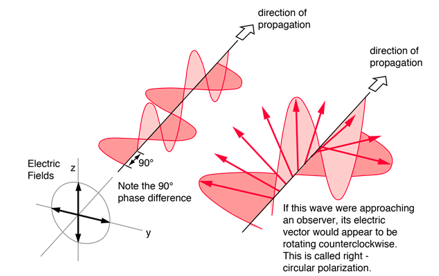
Light is considered to be circularly polarized if it is made up of two plane waves of identical amplitude but 90° phase difference. If you could see the tip of the electric field vector approaching you, it would appear to be travelling in a circle. The light is said to be right-circularly polarized if the electric vector of the light travelling toward you appears to be rotating counterclockwise while staring at the source. Left-circularly polarized light if clockwise. As the light moves one wavelength closer to you, the electric field vector completes a full rotation. Another way to put it is that if your right hand's thumb were pointed in the direction of light propagation, the electric vector would rotate in the direction of your fingers.
By passing linearly polarized light through a quarter-wave plate at a 45° angle to the plate's optic axis, circularly polarized light can be created.
Q4) What are Uniaxial Crystals?
A4)
A uniaxial crystal is an optical element that has a single optic axis. In other words, a uniaxial crystal has one crystal axis different from other two crystallographic axes. Ex: na=nb≠ nc. An unusual axis is the name given to this one-of-a-kind axis. A light beam divides into two parts when it passes through a uniaxial crystal, such as the ordinary ray and remarkable ray. The ordinary ray (o-ray) does not deviate as it goes through the crystal. At the air-crystal interface, the extraordinary ray (e-ray) deviates.
Negative uniaxial crystals and positive uniaxial crystals are the two types of uniaxial crystals. It is a negative uniaxial crystal if the refraction index of the o-ray (no) is greater than that of the e-ray (ne). It is a positive uniaxial crystal if the e-ray refraction index (ne) is less than that of the e-ray. (The refractive index is a measure of how well something reflects light.)
The ratio of the velocity of light in a vacuum to its velocity in the crystal). Examples of negative uniaxial crystals include calcite (CaCO3), ruby (Al2O3), etc. Examples of positive uniaxial crystals include quartz (SiO2), sellaite (MgF2), rutile (TiO2), etc.
Q5) What are Biaxial Crystals?
A5)
An optical element with two optic axes is known as a biaxial crystal. A light beam divides into two fractions when it passes through a biaxial crystal, both of which are exceptional waves (two e-rays). These waves travel in a variety of directions and at varying speeds. Biaxial crystal systems include orthorhombic, monoclinic, and triclinic crystalline forms.
The following are the Refractive Indices for a Biaxial Crystal:
1. The refractive index with the least value is (the corresponding direction is X)
2. The refractive index of the intermediate refractive index is (the corresponding direction is Y)
3. The refractive index with the highest value is (the corresponding direction is Z)
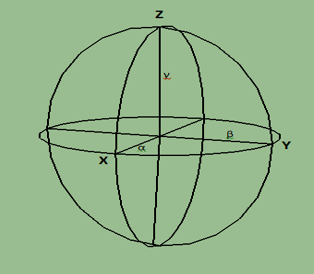
Figure: A Biaxial Crystal's Indicatrix. (An indicatrix is an imaginary ellipsoidal surface whose axes represent the refractive indices of a crystal for light passing through it in different directions.)
However, these optical directions and refractive indices are different from the crystallographic axes on the nature of the crystal system.
Orthorhombic crystal system –optical directions correspond to crystallographic axes. Ex: X, Y or Z directions (α, β and γ refractive indices) may parallel to any of the crystallographic axes (a, b or c).
Monoclinic crystal system – one of the X, Y and Z directions (α, β and γ refractive indices) is parallel to the b crystallographic axis while other two direction is not parallel to any crystallographic direction.
Triclinic crystal system –none of the optical directions coincide with crystallographic axes.
There are two types of biaxial crystals such as, negative biaxial crystal and positive biaxial crystals. Negative biaxial crystals have their β closer to γ than to α. Positive biaxial crystals have their β closer to α than to γ.
Q6) Explain Light Propagation in Uniaxial Crystal.
A6)
(1) The index ellipsoid is utilized to determine the two refractive indices and two related D directions for the two independent plane waves that can propagate in the k direction.
(2) An ellipse is formed when the plane through the origin and perpendicular to k coincides with the index ellipsoid.
(3) D1 is perpendicular to the optical axis z and lies in the x-y plane. D2 is located in the z-k plane. D1 is known as the ordinary wave, whereas D2 is known as the remarkable wave.
(4) The intersection ellipse's two axes are
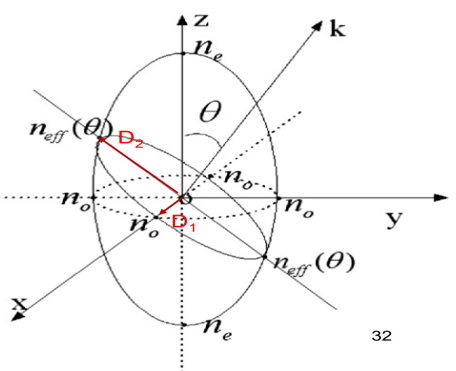
Q7) State Double refraction in Brief.
A7)
Double refraction, also known as birefringence, is an optical characteristic that occurs when a single ray of unpolarized light enters an anisotropic medium and splits into two rays, each going in a different direction. One ray (known as the extraordinary ray) is bent, or refracted, at an angle as it travels through the medium, while the other ray (known as the ordinary ray) travels through the medium unaltered. When two materials, glass and calcite, are compared, double refraction can be seen. Only one picture will be seen if a pencil mark is drawn on a sheet of paper and then covered with a piece of glass; but, if the same paper is coated with calcite and the crystal is orientated in a precise manner, two marks will become visible.
The phenomena of two-fold refraction through a calcite crystal is seen in the diagram. When an incident ray enters the crystal face at C, it splits into the ordinary ray CO and the extraordinary ray CE. However, if the incident ray enters the crystal parallel to its optic axis, the light ray will not be divided.
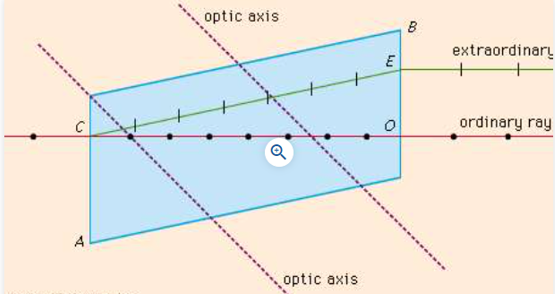
The ordinary and extraordinary rays are polarized in planes oscillating at right angles to each other in double refraction. Furthermore, the ordinary ray's refractive index (a number that determines the angle of bending specific to each medium) is constant in all directions; the extraordinary ray's refractive index varies depending on the direction taken because it has components that are both parallel and perpendicular to the crystal's optic axis. An extraordinary ray can move faster or slower than an ordinary ray because the speed of light waves in a medium is equal to their speed in a vacuum divided by the index of refraction for that wavelength.
The phenomenon of double refraction occurs in all transparent crystals except those of the cubic system, which are generally optically isotropic: ice, mica, quartz, sugar, and tourmaline are some well-known examples. Under certain conditions, other materials may become birefringent. When solutions containing long-chain molecules flow, they exhibit double refraction, a phenomenon known as streaming birefringence. When plastic materials made up of long-chain polymer molecules are compressed or stretched, they can become doubly refractive; this is known as photoelasticity. When put in a magnetic or electric field, or when subjected to external stress, some isotropic materials (such as glass) may display birefringence.
Q8) Define Double Refraction.
A8)
Light is split into two rays as it passes through a calcite crystal. The mechanism is known as twofold refraction, and it was first described by Erasmus Bartholinus in 1669. The calcite polarizes the two rays of light in such a way that the planes of polarization are mutually perpendicular. The two planes of polarization are also perpendicular to the plane of incidence for normal incidence (a Snell's law angle of 0°).
Snell's law predicts that the angle of refraction will be 0° for normal incidence (a 0° angle of incidence). At least one of the two beams must violate Snell's Law as we know it in the case of twofold refraction of a regularly incident ray of light. One of the two rays in calcite obeys Snell's Law; this ray is known as the usual ray (or O-ray). The other ray (and any other ray that does not follow Snell's Law) is a unique ray (or E-ray).
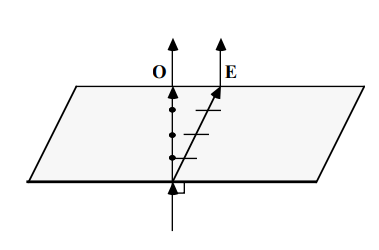
For conventional rays, the vibration direction is perpendicular to the ray path, as represented by the electric vectors in our drawings. The vibration direction of unusual rays is not perpendicular to the ray path. The wave normal is the direction perpendicular to the vibration direction. Although the ray path for extraordinary rays does not satisfy Snell's Law, the wave normal of unusual rays do. Snell's Law, in other words, relates the wave normal direction of the refracted ray to the wave normal direction of the incident ray.

Except for those in the cubic system, all clear crystals have the property of double refraction. The image separation is not large enough to be discernible in most crystals. We will, however, use the O E propagation direction or ray path wavelength wave as an example. Ordinary Other optical phenomena that emerge from double refraction are studied in Optics 3 2. There will be one O-ray and one E-ray for hexagonal and tetragonal crystals. There will be two E-rays for orthorhombic, monoclinic, and triclinic crystals. The refractive indices of non-cubic crystals are generally affected by the direction of vibration. As a result, non-cubic crystals are considered to be optically anisotropic. The refractive indices of the two beams produced by double refraction are usually not the same in most circumstances. One of the two rays will have a greater refractive index (and therefore a lower velocity) than the other; this ray is known as the slow ray. The fast ray is the other ray.
Q9) What is Nicol Prism? Explain its working.
A9)
Nicol Prism Nicol prism is an optical device which is used for producing and analyzing plane polarized light in practice.
Construction:
• The end faces PQ and RS of the calcite crystal PQRS are cut so that the angles in the primary section become 68° and 112° instead of 71° and 109° • The crystal is then cut diagonally into two halves. These parts' surfaces are first ground to make them optically flat, then polished.
• As a result, polished surfaces are joined using a special cement called as Canada Balsam.
Q10) Explain the Construction of Nicol Prism.
A10)
• When an unpolarized light beam strikes the face P′Q, it splits into two refracted rays known as O-ray and E-ray. These two beams are plane polarized, which means that their vibrations are at right angles to one another. The refractive index of Canada balsam cement is 1.55, which falls between the ordinary and extraordinary refractive indexes of 1.4864 and 1.4864, respectively. From the preceding description, it is evident that the Canada Balsam layer serves as an optically rarer medium for ordinary rays and an optically denser media for extraordinary rays.
• An ordinary ray of light passes from a denser to a rarer medium when it passes through the calcite crystal and into the Canada balsam cement layer. Furthermore, because the angle of incidence is greater than the critical angle, the incident ray is completely internally reflected by the crystal, leaving only exceptional rays to pass through the prism.
• As a result, the Nicol prism is used to generate a totally plane polarized wave.
Q11) Explain the Ordinary and extraordinary refractive indices.
A11)
There are two types of rays: ordinary and remarkable. The ordinary ray has a constant refractive index of no, but the extraordinary ray has a refractive index that varies depending on the direction of light transmission in the crystal.
In a 2D anisotropic crystal, the refractive index of an e-ray and an o-ray changes when the angle with regard to the optic axis changes. The charts show how the values of the refractive indices fluctuate in different directions inside a crystal, and the forms of the refractive indices of both negative and positive crystals are shown.
The forms of the refractive indices for ordinary and extraordinary rays in an anisotropic crystal are shown in the diagram below (o-ray in blue and e-ray in red). On the vertical optic axis, the rays have the same refractive index. The green line denotes the direction in which the refractive indices are calculated inside the crystal. We could modify our direction inside the crystal by adjusting (specified as the angle between the optic axis and the green line). The refractive indices of the two rays differ at different angles, which is why we obtain two different forms. The o-ray refractive index is constant at all angles, but the e-ray refractive index is elliptical. At 90 degrees, the difference between the refractive indices of the two rays reaches its maximum.
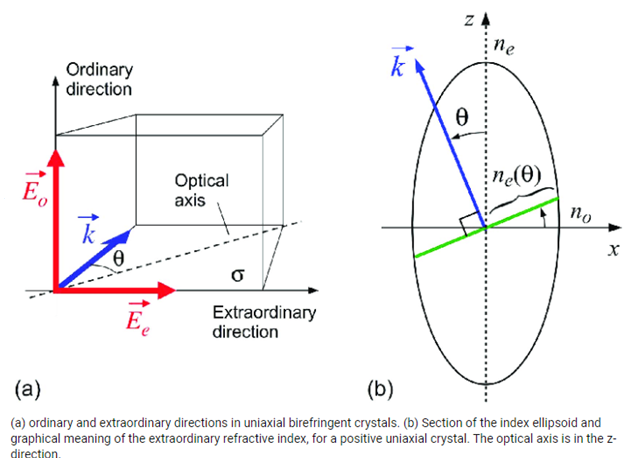
The second diagram depicts qualitatively how the refractive indices change for different directions in a crystal (which is described by the angle). If light is emitted from the origin in all directions, the variation of the refractive index with direction inside the crystal will result in different velocities in different directions (in the 2D example). The e-ray and the o-ray travel at different speeds. We may determine the velocity of the beam in that direction if we know the values of the refractive indices.
"ne(90)" denotes the e-ray refractive index, while "o" denotes the o-ray refractive index. The calculated value is displayed by varying. Any angle's "ne" value is displayed below the graphs. We could also figure out the refractive index forms of positive and negative crystals. We should alter the values of "ne(90)" and " " for positive crystals so that "ne(90)" > " ". We're dealing with negative crystals if the values are different.
This demonstration also depicts the locations within an anisotropic crystal where the beam velocities are the lowest and highest. The smallest velocity of light for positive crystals is at 90 degrees, while the maximum is along the optic axis, as seen in these figures. Because the velocity of light is inversely related to the refractive index, we get the lowest velocity along the optic axis and the highest velocity at 90 degrees for negative crystals.
Q12) What is Detection of Plane?
A12)
Light that is circularly and elliptically polarized (i) The light beam is permitted to fall on the Nicol prism in a plane polarized state. When the intensity of emitted light may be fully extinguished at two points in each rotation of a Nicol prism, the light is plane polarized. The light beam is allowed to land on a Nicol prism, resulting in circularly polarized light. If the intensity of emitted light remains constant when the Nicol prism is rotated, the light is either circularly polarized or unpolarized. The light is first transmitted through a quarter wave plate and then through a Nicol prism to distinguish between unpolarized and circularly polarized light. Because if beam is circularly polarized then after passing through quarter wave-plate an extra difference of λ/ 4 is introduced between ordinary and extraordinary component and gets converted into plane polarized. The light can thus be extinguished at two plates by spinning the Nicol. If the beam is unpolarized, it stays unpolarized after passing through the quarter wave plate, and there is no change in the intensity of emitted light when the Nicol is rotated.

Q13) Write a short note on Production of plane.
A13)
Light that is elliptically polarized. The light beam is permitted to pass through the Nicol prism. If the intensity of emitted light swings from maximum to minimum as the Nicol prism rotates, the light is either elliptically polarized or a mixture of plane polarized and unpolarized. The light is first transmitted via a quarter wave plate and then through a Nicol prism to distinguish between the two. Because, if beam is elliptically polarized, then after passing through quarter wave plate, an extra path difference of λ/ 4 is introduced between 0-ray and E-ray and get converted into plane polarized Thus, on rotating the Nicol, the light can be turned off in two places. If, on the other hand, the beam is a mixture of polarized and unpolarized, it remains a combination after passing through a quarter wave plate, and the Nicol intensity of radiated light fluctuates from maximum to minimum as the quarter wave plate is rotated.
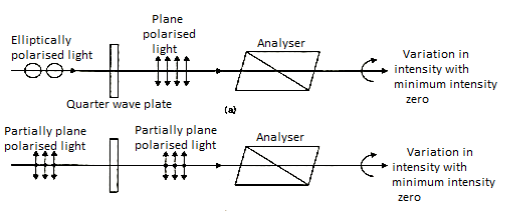
Q14) What is Circularly Polarized Light?
A14)
The fact that the absorption spectra of chiral substances measured with left- and right-hand circularly polarized light differ slightly can be explained by the fact that circularly polarized light is itself ‘chiral.' What is the reason for this? Chiral objects are helical objects. Take a look at the following photos of the bike stand:

Any helical object, such as this one, has a mirror counterpart that is helical but rotates in the opposite direction. The original and the mirror image are not the same. In certain ways, every chiral molecule has this helicity built in.
The left and right forms of circular polarization of light are mirror images of each other. Let's take a look at a circularly polarized light wave first. We solely consider the electromagnetic wave's electric field component. Consider superimposing (adding) two linearly polarized electromagnetic waves of equal amplitude and frequency (wavelength), but with the electric field vector oscillating in the xz plane in one case and the yz plane in the other. Assume that the waves go in the z direction. Voila! If the phase change between the two waves is exactly one quarter of the wavelength, you've got yourself a wave. We get a light wave in which the resulting electric field vector turns clockwise or anti-clockwise around a circle at any point along the z direction. This is why this light wave is referred to as circularly polarized. On the left, you can see an animation. If the two amplitudes are not quite equal, the electric field vector rotates clockwise or anti-clockwise on an ellipse, giving us elliptically polarized light.
Q15) State the Elliptical polarized light.
A15)
Let's pretend we're looking into optical rotation at a wavelength where the medium absorbs some of the light's energy. Because a chiral medium absorbs left- and right-hand circularly polarized light differently (the CD effect), after passing through the absorbing chiral medium, the amplitudes of the exiting two circularly polarized components of the light beam are no longer equal. They have a distinct amplitude and phase shift. As a result, we end ourselves in a predicament similar to the one illustrated in the right-hand animation (different amplitudes). In other words, the outgoing light beam is now elliptically polarized rather than linearly polarized. See the animation below, which was made with Mathematica in the same way as the one before but with one of the circular components losing amplitude as it goes through the optically active medium. At any fixed place, the ellipticity of the outgoing light is plainly evident in the electric field vector (orange).
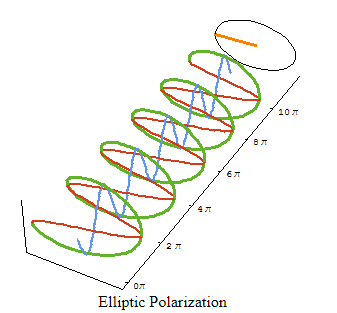
Because various absorption coefficients at that wavelength (or frequency) induce elliptic polarization, the amount of ellipticity is proportional to the strength of the circular dichroism. The distinction is that the CD is calculated by taking the difference between the absorption of left- and right-hand circularly polarized light. Ellipticity is the result of performing the experiment with both light polarizations at the same time (by starting out with linearly polarized light).
Q16) What are Phase Retardation Plates?
A16)
The Polarization State of light can be modified by the Birefringence of crystals, which is particularly useful in many applications. Birefringent wave plates or retardation plates are the names given to this sort of optical component (or just wave plates or retarders for short).
The extraordinary and ordinary rays' velocity through birefringent materials are inversely proportional to their refractive indices. When the two beams merge, the velocity difference causes a phase discrepancy. In the case of an incident linearly polarized beam this is given by a=2 d(ne-no)/(-phase difference; d-thickness of waveplate; ne, no-refractive indices of extraordinary and ordinary rays respectively;
d(ne-no)/(-phase difference; d-thickness of waveplate; ne, no-refractive indices of extraordinary and ordinary rays respectively;  -wavelength). At any specific wavelength the phase difference is governed by the thickness of the waveplate.
-wavelength). At any specific wavelength the phase difference is governed by the thickness of the waveplate.
Red Optronics provides the following waveplates: octadic-wave ( /8), quarter-wave (
/8), quarter-wave ( /4), half-wave (
/4), half-wave ( /2) and full-wave (
/2) and full-wave ( ) plates.
) plates.
Q17) Define Half Wave Plate.
A17)
The half wave plate can be used to rotate the polarization state of a plane polarized light as shown in Figure below.
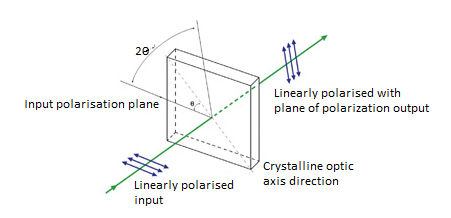
Suppose a plane-polarized wave is normally incident on a wave plate, and the plane of polarization is at an angle q with respect to the fast axis, as shown. After passing through the plate, the original plane wave has been rotated through an angle 2.
A half-wave plate is useful for rotating the polarization plane of a polarized laser to any desired plane (especially if the laser is too large to rotate). Vertical polarization is used in the majority of big ion lasers. Simply insert a half-wave plate in the beam with its fast (or slow) axis 45° to the vertical to achieve horizontal polarization. The  /2 plates can also change left circularly polarized light into right circularly polarized light or vice versa. The thickness of half waveplate is such that the phase difference is 1/2 wavelength (
/2 plates can also change left circularly polarized light into right circularly polarized light or vice versa. The thickness of half waveplate is such that the phase difference is 1/2 wavelength ( /2, Zero order) or certain multiple of 1/2-wavelength [(2n+1)
/2, Zero order) or certain multiple of 1/2-wavelength [(2n+1) /2, multiple order].
/2, multiple order].
Q18) State the Biot-Savart law.
A19)
In physics, the Biot-Savart law is a fundamental quantitative relationship between an electric current and the magnetic field it generates, based on tests conducted by French scientists Jean-Baptiste Biot and Félix Savart in 1820.
A magnetic field, or an area in space around the conductor in which magnetic forces may be observed, is created by an electric current running in a conductor, or a moving electric charge. The sum of all contributions from each small element, or segment, of a current-carrying conductor can be regarded the value of the magnetic field at a point in the surrounding space. The Biot-Savart law describes how the magnetic field value at a given place in space from a single short segment of current-carrying conductor is affected by each component that influences the field. To begin with, the value of the magnetic field at a given position is proportional to the current in the conductor as well as the length of the current-carrying section in question. The value of the field is also affected by the direction of the particular point in relation to the current segment. The field is largest when the line from the point to the short segment of current creates a 90° angle with the current segment or lies straight out from it. The field of the current segment decreases as the angle decreases, eventually becoming 0 when the point is on a line of which the current element is a segment. Furthermore, the magnetic field at a given point is proportional to its distance from the current element. The magnetic field is four times smaller at twice the distance, or the value of the magnetic field is inversely proportional to the square of the distance from the current source.
In a specific example, the Biot-Savart rule is used by adding up the contributions to the magnetic field at a particular position from all of the small current segments that make up a specific conductor of any shape. For example, the value of the magnetic field at a nearby location is directly proportional to the current and inversely proportional to the perpendicular distance from the wire to the provided point when a very long straight wire is carrying current. Ampère's law is a good example.
Q19) Explain Fresnel's Wave Theory of Light.
A20)
In 1819, Fresnel entered his work on diffraction into a competition held by the French Academy of Sciences on the subject. A number of prominent supporters of Newton's corpuscular model of light were on the judging panel, and one of them, mathematician Siméon-Denis Poisson, pointed out that Fresnel's model predicted an apparently absurd result: if a parallel beam of light falls on a small spherical obstacle, there will be a bright spot at the centre of the circular shadow—a spot nearly as bright as if the obstacle were not there. After an experiment by French physicist François Arago, the spot (later known as Poisson's spot) was discovered, confirming Fresnel's victory in the competition.
Despite this victory for the wave theory of light, the properties of polarized light seemed to be explained solely by the corpuscular theory, and Fresnel and Arago began studying the rules of polarized light interference in 1816. He was the first to achieve circularly polarized light in 1817. As a result of this observation, he came to the conclusion that light was a transverse wave rather than a longitudinal wave, as previously thought. (Young had come to the same conclusion on his own.)
Fresnel joined Arago on a government committee to upgrade French lighthouses in 1819, following Arago's advice. In 1821, he invented the dioptric system, which uses the refracting qualities of glass to create a device. He ringed a centre bull's-eye lens with a series of concentric glass prismatic rings on a lens panel. The panel concentrated light output by the lamp over a wide horizontal angle, as well as light that would normally escape to the sky or the sea, into a narrow horizontal pencil beam. In 1824, Fresnel was able to make numerous revolving beams from a single light source by spinning a number of lens panels around the lamp, which was an improvement over the mirror's single beam. To gather more of the light that was wasted vertically, he placed triangular prism parts above and below the main lens that refracted and reflected the light. He significantly increased the angle of incidence at which rays shining up and down might be captured and made to emerge horizontally by doing so. As a result, the full Fresnel catadioptric system was born.
Despite the fact that his work in optics got little public acknowledgment during his lifetime, Fresnel claimed that nothing could match to the joy of discovering a theoretical truth or experimentally proving a calculation.